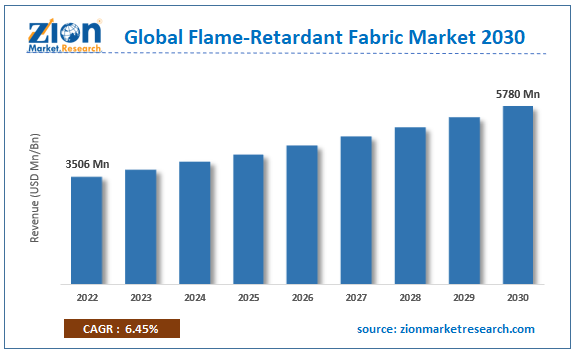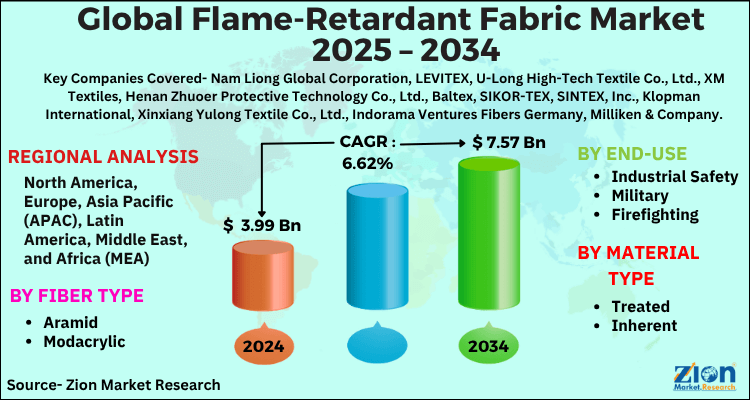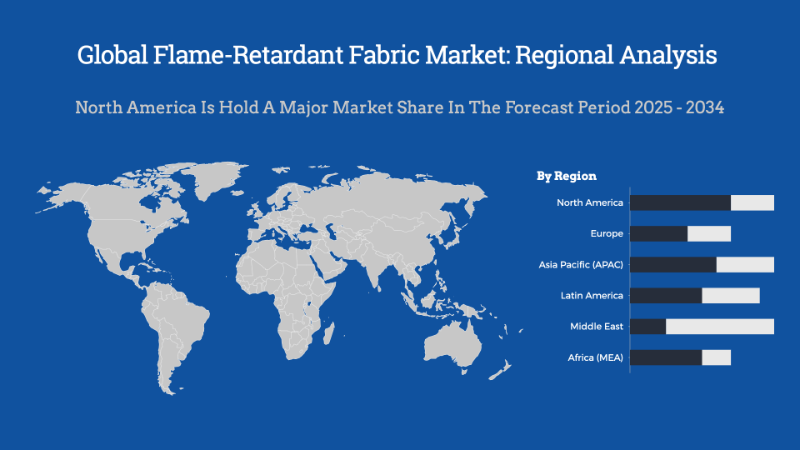Global Flame-Retardant Fabric Market Size, Share, Growth Analysis Report - Forecast 2034

Flame-Retardant Fabric Market By Fiber Type (Aramid, Modacrylic, Others), By End-use (Industrial Safety, Military, Firefighting, Others), By Material Type (Treated, Inherent), and By Region: Global and Regional Industry Overview, Market Intelligence, Comprehensive Analysis, Historical Data, and Forecasts 2025 - 2034
| Market Size in 2024 | Market Forecast in 2034 | CAGR (in %) | Base Year |
|---|---|---|---|
| USD 3.99 Billion | USD 7.57 Billion | 6.62% | 2024 |
Global Flame-Retardant Fabric Market: Industry Perspective
The global flame-retardant fabric market size was worth around USD 3.99 Billion in 2024 and is predicted to grow to around USD 7.57 Billion by 2034 with a compound annual growth rate (CAGR) of roughly 6.62% between 2025 and 2034. The report analyzes the global flame-retardant fabric market's drivers, restraints/challenges, and the effect they have on the demands during the projection period. In addition, the report explores emerging opportunities in the flame-retardant fabric industry.
The report delves deeper into several crucial aspects of the global flame-retardant fabric market. It includes a detailed discussion of existing growth factors and restraints. Future growth opportunities and challenges that impact the flame-retardant fabric industry are comprehensively addressed in the report.
Global Flame-Retardant Fabric Market: Overview
Flame-retardant fabrics are textile materials that are used for the protection of wearers against molten metal, flames, or when struck by arcs. They are different from fire-resistant materials and the main difference is the application of flame-retardant coating on these materials. They are also known as chemically flame-retardant fabrics and will burn when in contact with flame but at a much lower pace as compared to non-chemically treated fabrics. They are typically classified into three main segments including inherently flame retardant (IFR), flame retardant (FR), and durably flame retardant (DFR). Once the heat source is removed, these fabrics self-extinguish and do not melt even at high temperatures making them suitable for workers working in environments that are prone to heat-induced hazards. There is a growing market for flame-retardant fabrics as the end-user verticals are undertaking projects with higher risk quotient among other factors.
Global Flame-Retardant Fabric Market: Growth Drivers
Growing space exploration activities to drive market growth
The global flame-retardant fabric market is projected to grow due to the increasing space exploration activities conducted across the globe. As developed and emerging nations invest in higher space activities including building a stronger satellite system for communication or for exploring outer space for research purposes, the demand for ancillary accessories including flame-retardant fabric is expected to rise. There are several applications of these materials including use in creating spacesuits to equipment converse and sleeping bags used during manned missions. In one of the recent events, in May 2023, China launched a new manned spacecraft called the Shenzhou-16. Around 3 astronauts are a part of the mission which is expected to be 5-months long. Similarly in July 2024, Blue Origin, a privately owned space exploration company, completed the first flight of its spacecraft called New Shepard. It took 4 citizens to space and brought them back to the planet.
Growing exploration in creating other applications of the material to drive further expansion
There are growing initiatives to achieve product optimization in other end-user verticals as well including the fire firefighting industry. Firefighters are regularly subject to surroundings exhibiting higher temperatures and firefighting apparel of flame-retardant fabric is known to be helpful.
Restraints:
High cost of flame retardant fabric to restrict market expansion
The cost of producing flame-retardant fabric is exceptionally high. The type of material used in these fabrics is self-extinguishing and the heavier the fabric is, the higher its efficiency in flame-retarding. The main raw materials used for manufacturing may include natural fibers such as silk or synthetic material such as nylon and polyester. Certain manufacturers may also take the help of special chemicals to induce flame-retardant properties. Additionally, the manufacturing process is highly labor-intensive and complicated. It required skilled craftsmanship to meet commercial standards. All of this combined with other external factors including market conditions and availability of raw materials add to the high expense associated with flame-retardant fabric.
Opportunities:
Rising research and development to improve product efficiency may provide growth opportunities
The global flame retardant fabric market is expected to encounter higher growth opportunities led by the increasing research and development (R&D) in the production of more effective flame-retardant fabric. Governments across the globe have rolled-out stringent protocols in terms of worker safety at workplaces. This has further pushed the need for efficient fabrics. In June 2023, Birla Cellulose announced the launch of Birla SaFR, its latest innovation, at the International Textile Machinery Association (ITMA) 2024. The product is an inherent flame-retardant, phosphate-based, and sustainable cellulosic fiber that can be used to make flame-retardant fabrics. The company mentioned that they have focused on precision achieved by meticulous R&D. Similarly, in November 2022, Reliance Industries Ltd. (RIL), the world’s leading producer of polyester staple fibers and filament yarns, announced that it will start using Nofia® Technology to enhance the sustainable and flame-retardant attributes of Recron® FS, a fire-resistance polyester.
Challenges:
Failure to sustain flame-retarding properties after excessive use to challenge market expansion
Studies indicate that the inherent and chemically treated flame-retardant fabrics have certain disadvantages. For instance, the former type may not be as effective as expected in case the wearer encounters molten metal splash which limits their performance capabilities. In addition to this, chemically treated flame-retardant fabrics are known to cause discomfort upon wearing since the fabric is heavier as compared to other versions. There is a risk of the fabric losing its flame-retarding properties after excessive use and washing. In such cases, the safety of the wearer is compromised. In February 2022, firefighters in Boston, USA filed a lawsuit against 25 companies including DuPont and 3M over the use of ‘forever chemicals’ or the per-and polyfluoroalkyl substances (PFAS) chemicals in their workwear which resulted in 15 firefighters being diagnosed with some form of cancer.
Key Insights
- As per the analysis shared by our research analyst, the global flame-retardant fabric market is estimated to grow annually at a CAGR of around 6.62% over the forecast period (2025-2034).
- Regarding revenue, the global flame-retardant fabric market size was valued at around USD 3.99 Billion in 2024 and is projected to reach USD 7.57 Billion by 2034.
- The flame-retardant fabric market is projected to grow at a significant rate due to growing safety regulations, rising awareness of workplace fire hazards, increasing demand from high-risk industries like oil & gas and construction, and technological advancements enhancing fabric performance and comfort.
- Based on Fiber Type, the Aramid segment is expected to lead the global market.
- On the basis of End-use, the Industrial Safety segment is growing at a high rate and will continue to dominate the global market.
- Based on the Material Type, the Treated segment is projected to swipe the largest market share.
- Based on region, North America is predicted to dominate the global market during the forecast period.
Global Flame-Retardant Fabric Market: Report Scope
| Report Attributes | Report Details |
|---|---|
| Report Name | Flame-Retardant Fabric Market |
| Market Size in 2024 | USD 3.99 Billion |
| Market Forecast in 2034 | USD 7.57 Billion |
| Growth Rate | CAGR of 6.62% |
| Number of Pages | 227 |
| Key Companies Covered | Nam Liong Global Corporation, LEVITEX, U-Long High-Tech Textile Co., Ltd., XM Textiles, Henan Zhuoer Protective Technology Co., Ltd., Baltex, SIKOR-TEX, SINTEX, Inc., Klopman International, Xinxiang Yulong Textile Co., Ltd., Indorama Ventures Fibers Germany, Milliken & Company, DuPont, TenCate Protective Fabrics, and others. |
| Segments Covered | By Fiber Type, By End-use, By Material Type, and By Region |
| Regions Covered | North America, Europe, Asia Pacific (APAC), Latin America, The Middle East and Africa (MEA) |
| Base Year | 2024 |
| Historical Year | 2020 to 2023 |
| Forecast Year | 2025 - 2034 |
| Customization Scope | Avail customized purchase options to meet your exact research needs. Request For Customization |
Global Flame-Retardant Fabric Market: Segmentation Analysis
The global flame-retardant fabric market is segmented based on Fiber Type, End-use, Material Type, and region. All the segments have been analyzed based on present and future trends and the market is estimated from 2025 to 2034.
Based on Fiber Type, the global flame-retardant fabric market is divided into Aramid, Modacrylic, Others.
On the basis of End-use, the global flame-retardant fabric market is bifurcated into Industrial Safety, Military, Firefighting, Others.
By Material Type, the global flame-retardant fabric market is split into Treated, Inherent.
The Regional, this segment includes the current and forecast demand for North America, Europe, Asia Pacific, Latin America,and the Middle East and Africa.
Global Flame-Retardant Fabric Market: Regional Analysis
The flame-retardant fabric market exhibits strong regional dynamics, with Asia-Pacific leading due to rapid industrialization, booming construction activities, and stringent safety regulations in countries like China and India. North America follows closely, driven by robust demand from industries such as oil & gas, defense, and automotive, alongside stringent workplace safety norms. Europe also commands a significant share, fueled by strict fire safety standards and high adoption in protective clothing for industrial workers. Meanwhile, regions like the Middle East, Africa, and Latin America are witnessing steady growth as awareness of fire safety rises and infrastructure projects expand, creating new opportunities for flame-retardant fabric applications across diverse sectors.
Global Flame-Retardant Fabric Market: Competitive Analysis
The report provides a company market share analysis to give a broader overview of the key market players. In addition, the report also covers key strategic developments of the market, including acquisitions & mergers, new product launches, agreements, partnerships, collaborations & joint ventures, research & development, and regional expansion of major participants involved in the flame-retardant fabric market on a global and regional basis.
The global flame-retardant fabric market is dominated by players like:
- Nam Liong Global Corporation
- LEVITEX
- U-Long High-Tech Textile Co. Ltd.
- XM Textiles
- Henan Zhuoer Protective Technology Co. Ltd.
- Baltex
- SIKOR-TEX
- SINTEX Inc.
- Klopman International
- Xinxiang Yulong Textile Co. Ltd.
- Indorama Ventures Fibers Germany
- Milliken & Company
- DuPont
- TenCate Protective Fabrics
Global Flame-Retardant Fabric Market: Segmentation Analysis
The global flame-retardant fabric market is segmented as follows;
By Fiber Type
- Aramid
- Modacrylic
- Others
By End-use
- Industrial Safety
- Military
- Firefighting
- Others
By Material Type
- Treated
- Inherent
Global Flame-Retardant Fabric Market: Regional Segment Analysis
- North America
- The U.S.
- Canada
- Mexico
- Europe
- France
- The UK
- Spain
- Germany
- Italy
- Rest of Europe
- Asia Pacific
- China
- Japan
- India
- Australia
- South Korea
- Rest of Asia Pacific
- The Middle East & Africa
- Saudi Arabia
- UAE
- Egypt
- Kuwait
- South Africa
- Rest of the Middle East & Africa
- Latin America
- Brazil
- Argentina
- Rest of Latin America
Table Of Content
Methodology
FrequentlyAsked Questions
Flame-retardant fabrics are textile materials that are used for the protection of wearers against molten metal, flames, or when struck by arcs. They are different from fire-resistant materials and the main difference is the application of flame-retardant coating on these materials. They are also known as chemically flame-retardant fabrics and will burn when in contact with flame but at a much lower pace as compared to non-chemically treated fabrics. They are typically classified into three main segments including inherently flame retardant (IFR), flame retardant (FR), and durably flame retardant (DFR). Once the heat source is removed, these fabrics self-extinguish and do not melt even at high temperatures making them suitable for workers working in environments that are prone to heat-induced hazards. There is a growing market for flame-retardant fabrics as the end-user verticals are undertaking projects with higher risk quotient among other factors.
The global flame-retardant fabric market is expected to grow due to increasing safety regulations and stringent government mandates across various industries, growing awareness of fire safety, and technological advancements in developing more effective and sustainable flame-retardant materials.
According to a study, the global flame-retardant fabric market size was worth around USD 3.99 Billion in 2024 and is expected to reach USD 7.57 Billion by 2034.
The global flame-retardant fabric market is expected to grow at a CAGR of 6.62% during the forecast period.
North America is expected to dominate the flame-retardant fabric market over the forecast period.
Leading players in the global flame-retardant fabric market include Nam Liong Global Corporation, LEVITEX, U-Long High-Tech Textile Co., Ltd., XM Textiles, Henan Zhuoer Protective Technology Co., Ltd., Baltex, SIKOR-TEX, SINTEX, Inc., Klopman International, Xinxiang Yulong Textile Co., Ltd., Indorama Ventures Fibers Germany, Milliken & Company, DuPont, TenCate Protective Fabrics, among others.
The report explores crucial aspects of the flame-retardant fabric market, including a detailed discussion of existing growth factors and restraints, while also examining future growth opportunities and challenges that impact the market.
HappyClients
Zion Market Research
Tel: +1 (302) 444-0166
USA/Canada Toll Free No.+1 (855) 465-4651
3rd Floor,
Mrunal Paradise, Opp Maharaja Hotel,
Pimple Gurav, Pune 411061,
Maharashtra, India
Phone No +91 7768 006 007, +91 7768 006 008
US OFFICE NO +1 (302) 444-0166
US/CAN TOLL FREE +1 (855) 465-4651
Email: sales@zionmarketresearch.com
We have secured system to process your transaction.
Our support available to help you 24 hours a day, five days a week.
Monday - Friday: 9AM - 6PM
Saturday - Sunday: Closed







